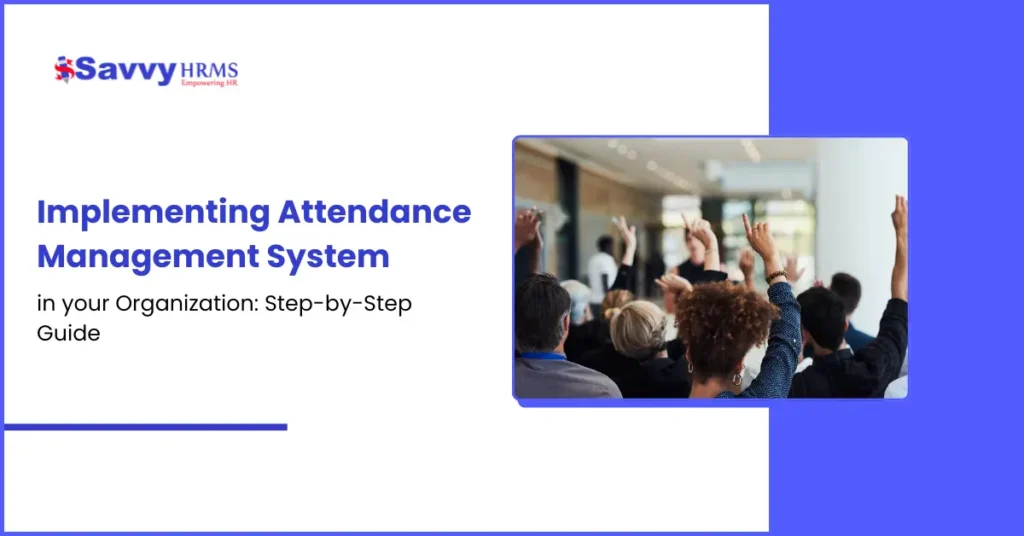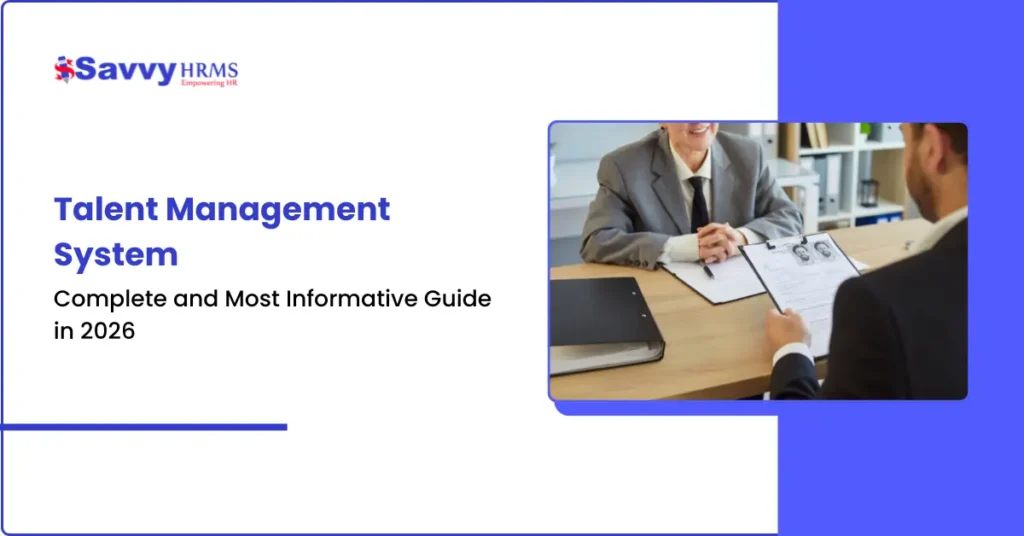Tired of manual attendance tracking eating up your HR team’s time? You’re not alone.
Many organizations struggle to keep up with attendance records, especially when managing hybrid and remote teams.
Here’s the good news: an attendance management system can transform how you track employee time, boost productivity, and simplify HR operations. In this guide, we’ll walk you through everything you need to know about implementing one successfully.
What Is Attendance Management System?
An attendance management system is software that records employee attendance, tracks working hours, and manages leave requests, all without the paperwork.
Instead of the old pen-and-paper registers, modern systems use:
Biometric tracking (fingerprint, face recognition), Mobile check-ins (app-based attendance), RFID cards (proximity-based entry), or Cloud-based portals (web access from anywhere).
The best part? These systems integrate seamlessly with your HRMS and payroll software. This means your employee data flows smoothly across platforms, reducing duplicate entry and errors.
Beyond just tracking time, a good attendance management system analyzes patterns, flags unusual absenteeism, monitors compliance, and helps your HR team make data-driven decisions.
8 Steps to Implement an Attendance Management System
Step 1: Evaluate Your Organization’s Attendance Needs
Before you pick a system, understand what you actually need.
Start by asking yourself these questions:
- Where are your employees located? (Office, remote, field, hybrid?)
- What are your current attendance challenges? (Manual errors, late tracking, compliance issues?)
- Do you have multiple shifts, flexible hours, or special requirements?
Talk to your department heads and managers. They’ll give you insights into real pain points that a system needs to solve.
Once you understand your needs, you’ll know exactly which features matter most, whether that’s biometric integration, mobile accessibility, or advanced reporting.
Step 2: Define Clear Attendance Policies
Don’t skip this step. Before implementing any system, spell out your attendance rules.
Create policies that cover:
- Late arrivals and early departures: What’s your grace period? What counts as tardy?
- Overtime rules: How is overtime tracked and compensated?
- Leave policies: How many days off, different leave types, approval workflows?
- Compliance requirements: What labor laws apply to your organization? (This varies by region and industry.)
When you feed these policies into your attendance management system, it enforces them automatically, reducing manual errors and keeping everyone on the same page.
Step 3: Choose the Right Attendance Management System
This is the critical decision. Not all systems are created equal.
When evaluating options, check these boxes:
- Compatibility: Does it work seamlessly with your existing HRMS and payroll system? Bad integration = headaches.
- Tracking method: Do you need biometric devices, RFID cards, mobile apps, or a mix? Choose based on your workforce.
- Key features: Look for leave management system, customizable reports, user-friendly dashboards, and real-time analytics.
- Cloud and mobile: Can employees check in remotely? Is the system accessible from anywhere?
- Security and support: Is your sensitive attendance data encrypted? Is there reliable customer support?
Don’t just go with the cheapest option. A system that doesn’t fit your needs will cost you more in the long run.
Step 4: Plan Integration and Data Migration
Moving to a new system is a big deal. Plan carefully to avoid disruptions.
Here’s what you need to do:
- Identify data to transfer: Current attendance records, employee information, leave balances, basically everything relevant.
- Coordinate with IT: Your IT team should ensure smooth connectivity between the new system and existing platforms like payroll and leave management.
- Time it right: Schedule the switch during slower periods so you don’t disrupt normal operations.
- Test the flow: Make sure data syncs correctly between systems before going live.
This planning phase might seem tedious, but it prevents chaos on day one and ensures payroll runs smoothly.
Step 5: Customize System Settings and Workflows
One size doesn’t fit all. Customize the system to your organization.
Configure:
- Shift timings and holidays: Input your company calendar and shift schedules.
- Leave types: Sick leave, personal leave, casual leave, unpaid leave, whatever applies to your organization.
- User roles and permissions: Decide who can approve leave, view reports, and manage settings. (HR staff, managers, and employees all need different access levels.)
- Automated notifications: Set alerts for absences, late arrivals, or pending approvals.
- Custom dashboards: Create views that matter to your team like attendance summaries, leave balances, and trends.
The goal? Make the system work for you, not the other way around.
Step 6: Train Your Employees Thoroughly
The best system in the world fails without proper training.
Invest in proper onboarding:
- Hold a workshop or webinar: Introduce the system, explain why you’re switching, and show the benefits.
- Demonstrate how to use it: Walk through marking attendance, whether it’s biometric devices, mobile apps, or web portals.
- Create a FAQ document: Answer common questions. Make it easy for people to find quick answers.
- Offer ongoing support: Be available during the transition period. Some employees will need extra help.
- Gather feedback: Ask employees what’s confusing or difficult. Use this to improve adoption.
Clear communication builds trust. When your team understands how the system helps them (no more manual sheets, instant leave approvals), adoption happens naturally.
Step 7: Test Before Launching
Don’t go live across the entire organization at once. Test first.
Run a pilot with one department or location:
- Check accuracy: Verify that attendance is recorded correctly.
- Test integrations: Make sure data flows smoothly to payroll and other systems.
- Find bugs: Hardware issues? Software glitches? Discover them now, not later.
- Gather feedback: Let pilot users share their experience. What’s working? What needs tweaking?
- Fix problems: Address issues before a company-wide rollout.
This testing phase usually takes 2-4 weeks. It’s worth the wait to avoid company-wide chaos.
Step 8: Monitor, Maintain, and Continuously Improve
Implementation day isn’t the finish line. It’s the beginning.
After launch, keep an eye on:
- System performance: Is attendance tracking reliable? Are there sync issues?
- User adoption: Are employees actually using it? Any resistance?
- Data accuracy: Pull reports and spot-check records. Are they correct?
- Generate reports: Run custom reports to find patterns, absenteeism trends, overtime spikes, etc.
- Plan updates: Stay on top of software updates and maintenance.
- Gather insights: Use the data to improve policies, identify problems, and optimize schedules.
A good attendance management system gets better over time as you refine processes and adapt to your organization’s evolving needs.
Common Challenges and How to Solve Them
Even with a solid plan, you might hit some bumps. Here’s what to watch for:
| Challenge | Solution |
| Manual attendance errors sneaking through | Use biometric or face recognition technology to eliminate manual entry |
| Poor integration with payroll system | Choose a system that’s built to integrate with your payroll software |
| Data syncing delays | Pick a cloud-based system with offline sync capabilities |
| Hardware failures (biometric devices down) | Keep backups and have a fallback manual process ready |
| Trouble transferring data to payroll | Use secure data transfer methods like encrypted USB or Bluetooth sync |
| Compliance issues with labor laws | Ensure the system generates auditable reports for regulatory requirements |
Why Choose Savvy HRMS?
If you’re looking for a reliable attendance management system, Savvy HRMS offers a solution built for modern organizations.
1. Flexible tracking methods
Use biometric devices, face recognition, mobile apps, or GPS-based check-ins, whatever fits your workflow.
2. Real-time accuracy
Automated tracking eliminates manual errors and gives you instant visibility into attendance patterns.
3. Seamless payroll integration
Your attendance data flows directly into payroll calculations, making salary processing faster and more accurate.
4. Easy leave management
Employees request leave through the system, managers approve instantly, and everything syncs with their attendance records.
5. Employee-friendly interface
Staff can check their attendance history, view leave balances, and request time off through a simple self-service portal.
6. Remote and hybrid support
Track attendance across locations with GPS-based marking, perfect for teams working from different places.
7. Strong security
Two-factor authentication and encrypted cloud storage keep your sensitive attendance data safe and compliant with labor laws.
8. Continuous support
Regular updates and dedicated customer support mean your system stays secure and current.
Conclusion
An attendance management system isn’t just a nice-to-have; it’s essential for modern HR operations. It cuts through the chaos of manual tracking, ensures compliance, integrates smoothly with your payroll, and gives you real insights into your workforce.
Whether you’re managing a small team or a large organization with multiple locations, automating attendance is an investment that pays off through saved time, improved accuracy, and better employee satisfaction.
Ready to make the switch? Start with your needs, choose the right system, plan your implementation carefully, and train your team properly.
With a solution like Savvy HRMS, you get a system that’s not just powerful, but also easy to use and built to grow with your organization. That’s what modern HR should look like.



